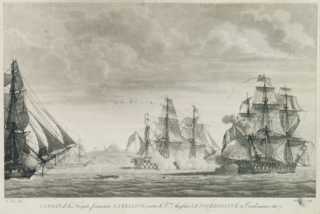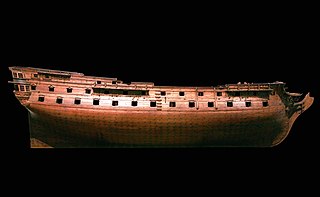
The Battle of Negapatam was the third in a series of battles fought between a British fleet, under Vice-Admiral Sir Edward Hughes, and a French fleet, under the Bailli de Suffren, off the coast of India during the American Revolutionary War. The battle was fought on 6 July 1782. Though the battle was indecisive, Suffren was stopped in his goal by Hughes and withdrew to Cuddalore, while the British remained in control of Negapatam.

The Fantasque was a Lion-class 64-gun ship of the line of the French Navy. She is famous for being captained by the French commander Pierre-André de Suffren during the American Revolutionary War.

HMS Coventry was a 28-gun sixth-rate frigate of the Royal Navy, launched in 1757 and in active service as a privateer hunter during the Seven Years' War, and as part of the British fleet in India during the Anglo-French War. After seventeen years' in British service she was captured by the French in 1783, off Ganjam in the Bay of Bengal. Thereafter she spent two years as part of the French Navy until January 1785 when she was removed from service at the port of Brest. She was broken up in 1786.
HMS Hannibal was a 50-gun fourth rate ship of the line of the Royal Navy, built by Adams of Bucklers Hard and launched on 26 December 1779. The French ship Héros captured Hannibal off Sumatra on 21 January 1782.

Bellone was an Iphigénie-class 32-gun frigate of the French Navy on plans by Léon-Michel Guignace. She took part in the American Revolutionary War in the Indian Ocean with the squadron under Suffren, and later in the French Revolutionary Wars. She was present at the Glorious First of June.
The Illustre was a 74-gun Magnanime class ship of the line of the French Navy. She took part in the War of American Independence and in the French Revolutionary Wars. Damaged beyond repairs during the Expédition d'Irlande, she was scuttled on 30 December 1796.

The Vengeur was a 64-gun ship of the line of the French Navy designed by Antoine Groignard. She saw action with Bailli de Suffren during the American War of Independence.

Admiral comte Pierre André de Suffren de Saint Tropez, bailli de Suffren, Château de Saint-Cannat) was a French Navy officer and admiral. Beginning his career during the War of the Austrian Succession, he fought in the Seven Years' War, where he was taken prisoner at the Battle of Lagos. Promoted to captain in 1772, he was one of the aids of Admiral d'Estaing during the Naval battles of the American Revolutionary War, notably taking part in the Siege of Savannah.
Pierre Servan René Bouvet de Maisonneuve was a French naval officer. He served in several notable battles, notably the action of 17 June 1778, and the battles conducted by Suffren in the Indian Ocean. He was wounded at the Battle of Porto Praya. He was the father of Pierre François Étienne Bouvet de Maisonneuve.

Brillant was a 64-gun Solitaire-class ship of the line of the French Navy.
Ajax was a 64-gun ship of the line of the French Navy.
Sévère was a 64-gun ship of the line of the French Navy.
Saint Michel was a 64-gun ship of the line of the French Navy, lead ship of her class.
Fine was a Sybille class 32-gun, copper-hulled, frigate of the French Navy.
HMS Fortune was a British 14-gun sloop launched in 1778 that the French captured in April 1780. She then served with the French navy under the same name.
Étienne-François de Cillart de Villeneuve was a French aristocrat and Navy officer, brother to Armand-François Cillart de Surville and Jean-Marie de Villeneuve Cillart.
The action of 12 August 1782 was a minor single-ship action that opposed the French 32-gun frigate Bellone to the British 28-gun HMS Coventry in the run-up to the Battle of Trincomalee. Although both ships were frigates, Bellone belonged to the Iphigénie class and was a comparatively large frigate for her time, carrying a battery of 18-pounder long guns, while Coventry was a sixth-rate armed only with 9-pounder long guns. Furthermore, Bellone had the advantage of the wind. The nominal crew of Coventry was about tho thirds of that of Bellone, but in the occasion it was reinforced by the troops she was carrying. In spite of these overwhelming odds, Coventry managed to inflict heavy casualties on Bellone, and most decisively to shoot most of the senior staff. The resulting confusion on Bellone allowed Coventry to escape to Madras.
Lézard was a 16-gun Cerf-class cutter of the French Navy. She was built in 1781, and took part in the Indian theatre of the Anglo-French War. She was captured by the 74-gun HMS Sultan in October 1782 at Trinquebar, and later returned to France.
Naïade was a 20-gun Coquette-class corvette. She took part in the Indian theatre of the Anglo-French War with the squadron under Suffren. The British Royal Navy captured her in 1783 but never commissioned her; it sold her in 1784.

Singe was a Renard-class xebec of the French Navy, launched in 1762. She served in the Mediterranean against the Barbary pirates, and is notable for a number of important officers who served aboard, notably Flotte, Raimondis and Suffren.






